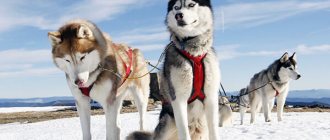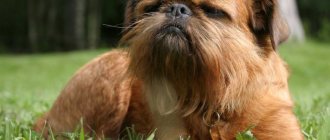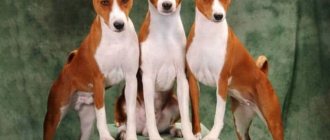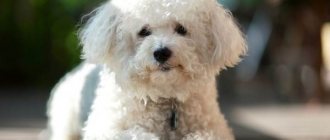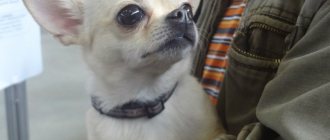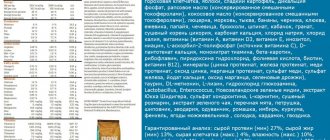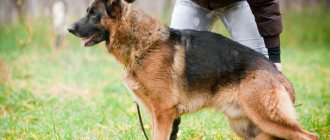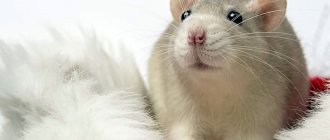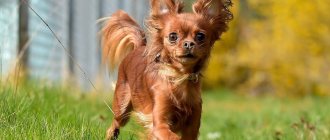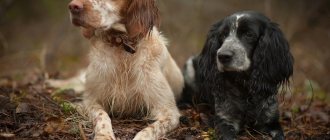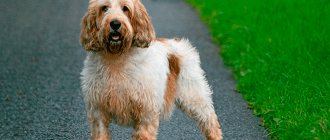Brussels Griffon , although it looks a little rustic, “rustic”, belongs to the decorative breeds of dogs; moreover, dogs of this particular breed have been the favorites of European monarchs for many centuries. They have a characteristic facial expression - impudent and arrogant, but this does not at all affect their character; they are devoted and loving pets.
There are three types of dogs - Griffons: Belgian, Brussels and Petit Brabançon, the birthplace of all these breeds is Belgium.
History of the breed
Dog handlers still have not agreed on which dog breeds became the ancestors of the Brussels Griffons. There is a version that the ancestors were rat-catching dogs that lived in poor Belgian neighborhoods and stables; they were used to catch rats. Perhaps the ancestors of these rat-catchers were Affenpinschers, Pugs and Ruby Spaniels. But another group of researchers is of the opinion that the ancestors of the breed were Irish and Yorkshire terriers.
It was thanks to the ability to catch mice that Griffons began to be found in royal castles, where they quickly gained popularity among aristocrats.
The breed first appeared at a canine exhibition at the end of the 19th century, and soon received official recognition. From that moment on, Griffons gained popularity outside of Europe, especially in the USA.
As a result of two world wars, the dog population in Belgium decreased significantly; new dogs began to be imported from England and the USA. Thanks to the fruitful work of dog handlers, a breed standard was developed and adopted in 1998 and 2003.
People often ask how to spell the name of the breed. So, the correct name is Brussels Griffon, not Griffon!
Character
Griffons, despite their decorative appearance, were originally rat-catching dogs - the ancestors of the breed were agile and agile small dogs that lived near stables and whose task was to catch rats. To this day, the breed has not lost its passion and working qualities.
Breeder's observations: Griffon can hardly be called a monogamous breed. He loves all people together, makes contact with strangers very easily, moves to a new home, and stays for foster care without any problems. Thanks to this, griffons adapt well to new environments.
Left alone, griffons tend to sleep soundly, in this respect they resemble cats. But if they get bored, like any dog, they can become involved in sabotage during puppyhood. Therefore, it is worth providing your pet with a variety of toys.
Griffons are very smart. They quickly learn the rules of living in the house, the habits of the owners and adapt remarkably well to them, demonstrating their best qualities. Thanks to this, they are able to quickly win the hearts of every family member. The breed is very sociable and needs constant contact with its owners.
Griffons are thinking dogs, humanly intelligent. They assess the situation and plan their actions several steps ahead. Males are more straightforward, “girls” are more cunning. These kids will not miss out on their benefits.
Griffons get along well with other animals, including cats and parrots. However, some individuals can hunt birds or small animals. The hunting instinct in them is still well developed. But if the puppy grows up in a house with other animals, there are no problems.
The Griffon is peaceful, but if it gets into a fight with another dog, it will not yield.
Griffons get along well with children and play happily with them.
Breeder's observations: Representatives of the breed are almost impossible to piss off. They are not touchy or vindictive.
Aggression or cowardice are not typical of griffons. Manifestations of these qualities are a marriage.
Griffons are clean dogs, but the degree to which this quality is expressed depends on individual characteristics. There are dogs who would never agree to get their paws wet in a puddle, while others are ready to run happily through the mud.
Some griffons snore in their sleep, and sometimes the volume of their roulades can rival that of longshoremen.
In their youth, griffons are very active, ready to rush from morning to evening. With age they become calmer and more reasonable.
Griffons tolerate the road well and usually sleep on the way. The main thing is to protect them from overheating at extremely high temperatures or from hypothermia at low temperatures.
Griffons are emotional and do not hide their feelings. They have very expressive facial expressions; literally all the nuances of their mood are reflected on their faces.
However, do not forget that each dog has its own character. Moreover, the griffon, which is the only pet in the family, behaves completely differently from griffons that live in a “pack”.
Description of the breed
Brussels Griffons are compact, slightly square-bodied dogs, and they also have a large head, especially in relation to the body.
The length of the body from the shoulder-scapular joints to the ischial tuberosities should be equal to the height of the dog at the withers.
None of the breed standards stipulate the height of the dog. As a rule, it is 25–36 cm in males, 23–32 cm in females, and the weight varies from 2.5 to 6 kg.
Griffons have a wide, rounded skull, the transition from the forehead to the muzzle is very clearly defined. The muzzle is quite short, according to the standard no more than 15 mm.
The Griffon's tightly closed lips are adjacent to the jaw, and the upper lip does not sag and does not overlap the lower one; there should be no jowls. They have a pronounced undershot, the lower wide jaw is curved upward and protrudes noticeably beyond the upper. The incisors on both jaws are located in one line. If the dog's mouth is closed, then the teeth should not be visible.
Dogs have a jet-black nose, the nostrils are wide and open. If you look at the dog from the side, you can clearly see that the nose, forehead and chin are located in the same plane. On the small muzzle, large round eyes with tight-fitting eyelids, brown in color, stand out as a dark spot, and the darker they are, the better.
Griffons have small, neat ears that are set wide apart. In some countries they are cropped, and the ears become erect and pointed; if this does not happen, then they remain semi-erect and droop forward.
The neck is not long, flowing smoothly into a short back with a slightly arched loin with good muscles. The chest is quite wide and deep, the ribs are curved. The stomach is tucked.
The tail is set high, it can either be docked at 75% of the length or left at its natural length; the Brussels Griffon wears this tail raised up, without curling it into a donut.
The fore and hind legs are widely spaced and parallel to each other, the muscles are well developed. Elbows should point straight back and not be turned out.
The hock joints are low and not turned out. The paws are small and compact, with the toes neatly gathered into a ball, the pads are dense and elastic, the claws are dark. It is desirable that there are no profitable fingers.
Coat
The coat of this type of Griffon is hard and thick, with a slight wave and undercoat. The coat is of medium length, so the dog’s silhouette is not hidden, but on the face, especially near the eyes and nose, the hair is elongated, and there is an extravagant beard on the chin and “eyebrows” above the eyes.
In color, only red is allowed, the only exception is a little black on the mustache and beard. The color of the coat can be of different intensities, but preference is always given to the brighter color.
According to some publications, it belongs to the short-haired breeds, although this is a very controversial point. In our opinion, it should be classified as a medium-haired breed, like its brother, the Belgian Griffon.
Possible disadvantages
Any discrepancies with the standard are considered deficiencies. Thus, disqualifying defects for the breed are:
- dentition disorders;
- nose color is not black;
- the tail is broken or curled;
- a tongue protrudes from a closed mouth;
- the lower jaw is distorted;
- any color other than black, or spots of a different color on the body.
In Brussels Griffon males, the testes should be completely descended into the scrotum.
How to choose a puppy
Before purchasing a Brussels Griffon, it is important to create suitable conditions for keeping your future friend. A bed, bowls, toys, harness, dog hygiene products - only after purchasing these necessary things should you start looking for a kennel. Breeders who specialize in the breed are mainly located in large cities. If you live on the periphery, carefully consider the return journey - already in the company of a four-legged friend.
How do you like my bite?
Once a suitable Brussels Griffon kennel has been found, you can begin to select the gender of the puppy. Remember that males are distinguished by independence and a tendency to aggression, and females are distinguished by obedience and devotion. The latter can create additional discomfort during estrus: while walking with your pet, it is unlikely that you will be able to hide from the crowd of four-legged “suitors.”
If you have already decided on the gender of your future pet, it’s time to take a closer look at the candidates! The optimal age for purchasing a puppy is 6-8 weeks. Babies who are torn away from their mother early in most cases grow up weak and unadapted. In addition, the mental state of such a griffon leaves much to be desired: the puppy lacks primary socialization skills.
When choosing a Brussels Griffon, take a close look at the entire litter. If the kids are mostly shy or even aggressive, ask the breeder to introduce you to another dog family. Healthy Brussels cats should be curious, playful and cheerful. This is easy to check: take a bunch of keys or a rattle in your hand and extend it towards the puppies. Babies who feel great will immediately be attracted to a new sound and smell.
Pay attention to the griffon's build. You should not choose the most well-fed puppy, but excessive thinness of the animal should also alert you. Give preference to a medium-sized baby, carefully examine it from all sides. The coat should be thick, without bald spots; eyes and ears – clean; paws - undamaged. A healthy Brussels resident should not cough or sneeze.
The last step on the path to selfless friendship with the griffon is obtaining documents. A conscientious breeder must provide the buyer with a vaccination certificate for the puppy, his passport and proof of pedigree. It is worth asking him in more detail about the maintenance of Brussels Griffons, and especially about the diet of the chosen baby. For positive adaptation, it is not recommended to suddenly change the puppy’s diet.
Interesting photo
Prices for puppies and adult dogs
To purchase a real Brussels Griffon, it is best to contact a nursery. Don’t be afraid of the relatively high price for a puppy, since from the moment of purchase a loyal, reliable, and most importantly quite predictable friend will appear in the family. In a specialized nursery, a puppy will cost from 250 to 600 US dollars. From an ordinary, private breeder, the price is strikingly lower - 100-150 US dollars. However, if you buy a dog outside of a kennel, you cannot be completely sure of the purebred of the puppy.
If the breeder decides to purchase an adult dog, then the price will be slightly higher, since its cost depends on the working properties of the dog and ratings in competitions. Thus, the most expensive dog will be an adult dog of the highest competition and exhibition level, properly trained and absolutely healthy.
Education and training
In addition to the appearance of a wise old man, the Brussels Griffon is also notable for its inquisitive mind. Even two-month-old puppies easily understand what is wanted from them, so their education should begin as early as possible. First, clearly define the position of the leader: the griffon should not allow the idea that he is the head of the family. Brussels tend to be dominant, so this breed is not suitable for people with a soft character.
Although Griffons have a reputation for being quite intelligent dogs, they can be difficult to train. The animal often shows stubbornness and willfulness, so training will require a lot of time and effort. At the same time, the Brussels Griffon is one of the most trained miniature breeds. It’s worth starting by learning the basic commands: “Sit!”, “Lie down!”, “Voice!”, “Come to me!”, “Give me your paw!”, “Near!”, “You can’t!” If necessary, you should seek the services of a professional dog handler.
During the training process, use your main weapons - consistency and patience. Use only positive methods: treats, encouragement, or affectionate stroking behind the ear. It is not recommended to raise your voice at a dog: after such humiliation, the griffon will not soon be in a training mood.
In addition to teams, it is worth involving the Brussels Griffon in individual sports - in particular, agility. During the obstacle course, the animal will not only repeat the commands it has already learned, but will also stretch its paws to its fullest. In addition, communication with the owner and four-legged relatives will only be beneficial.
Pros and cons of Griffon
Like any dog breed, the Brussels Griffon has both weaknesses and strengths. The advantages of the breed are:
- healthy gastrointestinal organs;
- endurance;
- innate balance and goodwill;
- activity;
- fearlessness;
- the dog is hypoallergenic;
- desire to learn.
The pitfalls of the breed include the following factors:
- great natural selection in the first days after birth;
- predisposition to various eye diseases;
- difficult birth.
Thus, the disadvantages are the physiological characteristics of the breed, but only good things can be said about the character of this breed.
Diseases characteristic of griffons
Brussels residents have a fairly strong immune system and rarely get colds. But this breed can suffer from the following pathologies:
- Difficult birth. Many small females are unable to deliver their babies on their own and have to resort to caesarean section.
- Eye diseases: Loss of eyeballs (the eye bulges, swells and turns red). It is dangerous due to visual impairment and even loss of an eye; treatment is surgical.
- Irregular growth of eyelashes (distichiasis). Hairs grow on the inside of the eyelids, causing corneal ulcers. Only excision of hair follicles helps.
- Cataract (clouding of the lens). Risks of blindness. Treatment is surgical.
Griffons live from 12 to 14 years, but there are also long-livers who have crossed the 16-year mark.
Features of care and maintenance
Properly caring for such a pet will not be difficult. Since these dogs have coarse hair structure, they require special care.
Griffons cannot be cut. To rid your pet of dead hair, you need to trim it: a small amount of hair is pinched between two fingers and smoothly pulled in the direction of hair growth, as a result, dead hairs remain between the fingers. This procedure is quite long-term, but a professional can handle it faster, so it’s better to contact a groomer.
Griffons love water treatments, so they will happily bathe once every 6-8 days; to wash them, you should purchase a specialized dog shampoo.
The dog must be combed daily with special combs or a glove, and this is especially effective during the animal’s molting season. The dog's face needs special care. The first step is to carefully trim, and after that, too long hairs can be carefully trimmed with scissors. After every walk and meal, the folds on the face should be wiped, this will help avoid many infections.
Claws need to be trimmed once every two months, preferably after bathing; a nail clipper will help with this. The dog's eyes also need to be carefully looked after - if they begin to sour, they must be wiped with a cotton swab dipped in a decoction of chamomile or strong black tea.
The griffon needs to brush its teeth weekly; special brushes and toothpastes for dogs are used for this.
Do not forget about antiparasitic therapy - every month the dog must be treated for fleas and ticks and once a quarter for helminths; products for such procedures can be purchased at a veterinary pharmacy.
Diet
Immediately after purchasing a puppy or adult Griffon, you should discuss its diet with a veterinarian or specialist who is familiar with this breed. They can be fed either with ready-made dry food, choosing only premium food, or with natural products - the choice is yours. If the owner decides to choose dry food, then it is important to follow the instructions and not give more food than the manufacturer recommends.
Dogs that eat dry food need plenty of drinking water.
If the choice fell on natural products, then it is advisable that the dog eats freshly prepared food and only from the right products. The dog's diet should include:
- Meat can also be given raw, but only if the breeder is confident in its high quality, it can be chicken, beef, rabbit, turkey;
- Boiled sea fish, boned;
- Cereal porridges – buckwheat, oatmeal, rice;
- Vegetables and fruits, both raw and after heat treatment;
- Lactic acid products, preferably with low fat content;
- Eggs, but no more than one per week;
- Butter and sunflower oil – 5-10 grams per day.
Feeding your dog table scraps is strictly prohibited.
Also extremely undesirable:
- spices;
- smoked and pickled food;
- confectionery;
- tubular bones.
The dog should not overeat, this can lead to serious obesity. A puppy should be fed 4 times a day, and an adult dog twice a day, at the same time.
What kind of owner does a griffon need?
The breed can be recommended to people who want to have a lively, energetic, fairly hardy dog with whom they can both walk in the fresh air and have a pleasant conversation at home.
A Griffon can even be taken as a first dog. They are easy to care for and train, and their wonderful character is difficult to spoil.
Breeder's recommendation: It is better to take a male as a pet. The bitch goes into heat twice a year, and this creates certain inconveniences and restrictions.
Health
Brussels Griffons are not particularly healthy; their life expectancy is 12-14 years. They have a predisposition to certain diseases. As a rule, pathologies of the organs of vision are especially common among them. Griffons are susceptible to the following diseases:
- cataract;
- narrowing of the nostrils;
- eyelash growth;
- retinal atrophy;
- prolapse of the eyeball;
- hydrocephalus.
Another feature of the breed is difficult childbirth, often ending in caesarean section.
Brief historical background
There are several versions of the origin of griffins. According to one of them, the ancestors of these small funny dogs were dogs called smousje, who lived in peasant farms in the vicinity of Brussels several centuries ago (14-15 centuries) and were engaged in the extermination of rodents (rats and mice), which were found in abundance in barns and granaries. The animals had a narrow, long muzzle, which helped them cope with their responsibilities better. The infusion of pug blood made them more miniature and aristocratic.
Some researchers believe that the Brussels was the result of deliberate crossing of Affen Pinschers with spaniels or wild Belgian dogs. Others believe that, on the contrary, German pinschers descended from the ancient griffons. There is an opinion suggesting the presence of an admixture of Yorkshire and Irish terrier blood. One way or another, cynologists came to an agreement in determining the exact date of the breed’s origin, believing that it appeared no later than the 30s of the 15th century. Some small dogs, extremely similar to modern Brussels griffins, were depicted on their canvases by painters of that time (Jan Van Dyck “The Arnolfini Couple”, 1434).
Artists often depicted dogs that looked like griffins in their canvases.
The breed became wildly popular among the nobility; even royalty (the Belgian Queen Marie-Henriette) bred it and kept it as pets. Court ladies and aristocrats almost never parted with their dogs and carried them with them everywhere.
The first official appearance of griffons occurred in 1880 at the Brussels dog show, but they were called a little differently - the small Belgian wire-haired terrier. In 1904, the first breed standard was written and approved, which was finalized and supplemented in 1963. The latest valid version of the standard dates back to May 5, 2003, in the FCI registry Brussels Griffons are listed under No. 80 in Group 9 (Companion and Toy Dogs), Section 3 (Small Belgian Dogs).
Brussels Griffons came to our country at the very end of the 20th century; in 1993, a couple of dogs were brought from the USA.
Reviews about the breed
Once you see the baby Brussels Griffon, you won’t be able to remain indifferent. Here are some reviews about the breed. The authors' style and punctuation have been preserved.
Julia
Our little griffon is a very kind and affectionate dog, everyone loves him. He quickly found a common language with all family members and became a loyal friend to his three-year-old daughter. Captures the mood from a glance and never gets in the way. They don't shed at all - there is no wool in the house. True, there is a minus - he likes to fool around and play with soft toys.
Andrey
We decided to get two griffons at once - Mickey and Mouse. Very funny and intelligent creatures. They got used to the toilet in just a couple of days, they don’t chew things and furniture. They quickly learned the basic commands and are happy to carry them out on walks. We are already hoping for offspring soon.
Elena
This is not a dog, but a real positive! Smart, kind and affectionate. He quickly became friends with a five-year-old cat, and now they even sleep together.
Brussels Griffon - reviews
- + Leave a review
Leave a review Reset
DrNef
https://irecommend.ru/content/kompanon-rebenok-i-luchshii-drug
I dreamed of a dog for a long time, and finally decided. The long days of choosing a breed have arrived. It was important to me
- dog size (since I was a student and studied in another city)
- unpretentiousness in care (I was not ready to spend money on caring for the Yorkshire terrier’s coat)
- breed suitable for beginners (first dog)
- friendly character
- lack of predisposition to hereditary diseases
- "not fragility" of a dog
While looking through advertisements for the sale of puppies, I came across the outlandish Griffon breed. By that time, I had not seen dogs of this breed in person. After reading information about the breed on the Internet, I made a choice, because the Griffon was ideal for me.
So I had Rory - a friend, a child, a companion. Mom said he was scary when she first saw him. And now he visits him more often than me.
I digress, about character and habits a little later, but for now about the characteristics of Rory by which I looked for him and how applicable they were to him:
- Size: he is almost 7 years old and weighs 5 kg. Traveling by car or bus goes well; many passengers do not immediately realize that there is a dog in the cabin. Rory falls asleep on his lap or quietly munches on treats. There are no problems on the train either.
- Unpretentiousness in care: the only specific care is combing the beard and trimming. After moving to the village, I cut Rory’s hair using a clipper for people’s hair growth, which is a good alternative to trimming.
- The breed is suitable for beginners.
- Friendly character. He has never bitten anyone (seriously). Loves children. My friends, although more correctly than ours, he remembers and experiences an indescribable feeling of joy when meeting them, sometimes he does not want to leave them, forcing them to stay longer.
- No tendency to hereditary diseases. I only partially agree, since Rory has food allergies. And he tolerates hot weather much worse than other dogs, I think due to the lack of a nose (brachycephalic).
- Not the dog's fragility. Griffons have a wide chest, but the body is proportional. He looks more like a puppy than a small, fragile dog.
Other features identified after meeting:
- He snores when he sleeps, grunts when he sniffs - not always, but often. Sometimes he grunts to get attention.
- Recognizes one owner: won't go for a long walk with mom or husband if I'm at home, only to the toilet and home.
- A wonderful actor and ladies' man.
- Silent. Doesn’t bark or howl just like that, only if there’s a knock on the door or doesn’t like something (for some reason he doesn’t like a head of cabbage)
- Not a coward, he considers himself a big dog.
- More human than dog. Does not rely on smell, recognizes people by face and sometimes clothing (once he confused my mother with a similarly dressed woman)
- When I was a puppy, I was confused with a monkey.
- Excellent memory, including for those who offended.
- Learning ability: still learning something new
- Heat-loving (will prefer the floor next to the heater to his bed)
- In Siberia you will need clothes and shoes. Sun cap in summer, down jacket and boots in winter.
- Communicative.
- Suitable for people of different ages and rhythms of life. Except for being too active (Rory loves to run, but hates jogging).
The Griffon is a dog with a sense of self-esteem that will adapt to your rhythm of life and will follow you everywhere. He will be happy just to have you around.
Sometimes he looks like a toy with shiny button eyes, asking to be held at the end of a long walk. Sometimes like a brownie with tousled hair, begging for a tidbit. Sometimes like a lion protecting you from a suspicious person.
This is all later, because most likely when you see him for the first time you will think he is “scary”, and then he will win your heart.
odelle
https://irecommend.ru/content/laskovyi-balbes
So we have this charming dunce.
Our guy is smart, it feels like sometimes he understands more than he needs to. My husband and I try not to say certain things in front of him)).. At the new place, I immediately realized where to go to the toilet, that you can’t climb on the bed (although it happens sometimes). On the street he tries not to go far, but for now he runs away in euphoria to meet other dogs (we are trying to train him to respond to the owner’s call). And when he deigns to come running in response to an angry cry, he asks for forgiveness and spins around his legs with his tail between his legs.
He's not picky about food, but we don't indulge either. If he doesn’t eat, it means he doesn’t want to.
Ours is not particularly tame, he loves to be close to his owner, but he won’t sit in his arms for long, and he may not go to strangers at all. But at the same time, if he is picked up out of necessity (as he feels), for example, to the bus or to cross the road or dirty, then he sits calmly in his arms. In principle, we did not take a kitten, so that suits us.
Not for small children. He loves to play and be naughty. But he won’t allow himself to be squeezed like a toy.
It’s convenient in winter, when he curls up near his feet and warms him with the warmth of his body)) and in summer he just lies next to him, spreading his legs like a frog.
Almost does not shed, if you comb him for 10 minutes at least once every 1-2 weeks, then there will be no hair at all. There is no smell from them. Ours still smells like milk (6 months).
Ours is frozen, but I don’t consider this a particular drawback, because... This does not appear during an active walk. And if you stand still, then everyone can freeze.
Will not leave anyone indifferent))
MarikAreva
https://irecommend.ru/content/griffon-eto-super-drug
I've never had a dog. Only in childhood did my parents have a dogess. Very beautiful and smart, but more on that later.... About 3-4 years ago, a boom in small-sized dogs began. As a “fashionable” girl, I really wanted such a miracle for myself. I thought about it for a long time, and recently (a year ago) a female friend gave birth to a puppy. They called and asked if I needed a certain griffon. Without even knowing what breed it was, she said: Yes. Let's go and pick it up. I was as big as a palm. I hoped. that he will be like this))) But, now he is a year old and he has become very big. One and a half times more than mother and sisters. From here the conclusion is that the cables are much larger... The dog is very gluttonous, but does not eat EVERYTHING. Very picky. He always eats meat, doesn’t accept soups at all (even with meat), doesn’t eat porridge or anything like that. Loves cucumbers and fruits (almost everything). Walking around big and small was taught to walk outside quite quickly. The little one went to the patch (since it was winter, we didn’t go outside with him for a long time). They took me out once. so he immediately caught a cold. We decided not to take any more risks. In general, he is a quick learner. One might say, he understands perfectly. Looks into the mouth. Walks on his heels like a tail. You can't be at home alone. That's why they gave him a cat as a child as a friend. He still can't get used to it. But the cat thinks it’s mom. Very loyal, always there. Jealous. Although he quickly gets used to other people. Barks at people selectively. I like it, I don’t like it. He can run after what he likes). My griffon's name is Theo. And I love him very much, no matter what (even that he is not small at all :)) It is impossible to imagine a better friend. Attaching photo.
Juli25
https://irecommend.ru/content/bryusselskii-griffon-nadezhnyi-drug-gipoallergennyi-i-ne-linyaet
Brussels Griffon dog named Chip.
When the question arose about choosing a breed, it was necessary to choose a reliable friend for a 3-year-old little girl, so we settled on the Griffon. This is an affectionate, kind, sweet dog! Wouldn't hurt a fly! He gets along well with the child and with all family members. Chip is still a puppy; in May 2016 he will turn one year old.
The dog is obedient, from the first days he waits and endures until walking. Very smart, understands even the owner’s gaze, captures the mood. Since childhood he has been accustomed to dry food, but he loves to eat tasty things (meat, carrots, apples, cereals). True, when introducing a new food (we introduce a new product, gradually (once a week), it becomes weak, loose stools appear. Therefore, we try to give only special foods and those that are more expensive.
The dog needs to be cut periodically. Griffons are being trimmed. And once every two months a hygienic haircut is done: nails are trimmed, ears and teeth are cleaned more often. In summer and during tick season, we treat the dog with a special spray rubbed into the skin. This is reliable protection against all parasites.
These dogs do not shed at all and do not leave their fur on clothes or furniture. This is one of the breeds to which there are no allergies, which is very important, because a small child is constantly in contact with a dog.
Chip is our favorite and family member, our daughter treats him very kindly - like a little brother
Elena123456789101112131415
https://irecommend.ru/content/super-dobrozhelatelnoe-zhivotnoe
Not long ago I lost the love of my life...my wonderful sweet and best dog in the world...my Archibald...he was a Pekingese...
the emptiness in my soul was simply incredible...
I wanted to fill it somehow... half a year has passed since his death... and something else was simply needed….something completely new…different…. I wanted the same emotions... I wanted the same dog...
I automatically searched for advertisements with Pekingese dogs for sale... roared... and looked again... for something close... something dear... and couldn’t find it...
and as they say - I saw THIS... This is a wonderful miracle... black with bulging eyes... little one... it was our Fenka...
We went to “have a look”….they just didn’t know what kind of breed it was, it’s not popular in our city….
the first impression was simply stunning - our Fenka’s mother... from Brussels... loved us so much... literally and figuratively... right from the doorstep... right off the bat... it's simply indescribable... it feels as if we live together and came home from work…. rushed at us with her joy... the owner took her to another room so that she would let us interact with the puppies...
the puppies are the same... three, 2 Brussels dogs and a Belgian, attacked us with their simplicity and spontaneity... licked, jumped, caressed... such weirdos... indescribable feeling... from this crazy energy...
By the way, we came to see the dog with our one-year-old daughter... the whole family...
so they rushed around us like 3 little tops.... giving their joy and friendliness...
At that moment I felt better...
My husband and I found what we wanted...
in the end, after 2 weeks they took our beauty... They chose the calmest...of the three...Belgian black and tan....our Fenka....
They brought her home... and then it began...
in still waters... there are devils.... this awl in the butt jumps like a mountain goat, carries everything, tears everything, gnaws everything... climbs everywhere, climbs on tables, steals from under your nose.....
I still don’t understand how, after my imposing Archibald, I could fall in love with this louse???!!!
She is so friendly, sweet, spontaneous, she loves my daughter so much... and my daughter loves her that I just don’t have a choice - I “have to” love her)))))
About the facts: - very intrusive, and without exaggeration - very loving and do not understand that not everyone is happy with them.
- absolutely harmless... I never saw any aggression from her.... to no one...
- super dogs for families with children - you can be 100% sure that your dog will never offend your child... he will tolerate pulling his ears, paws, tail, and kissing your child... he tolerates everything and is very sincerely loves….I have never met anything like this….
— active-super-active….
- very bouncy - mine climbs tables... without a twinge of conscience..
- very smart - naive, kind, but very smart...
- great in terms of care - no hair in the apartment...if trimmed on time....
- miniature - mine weighs 4 kg... but there are also larger ones...
- eats everything - pencils, children's toys, linoleum, upholstered furniture... flowers, apples - everything in a row
— they absolutely do not understand weight categories; they communicate with large breeds on equal terms, which makes them shocked….
- sleeps where it’s warm and nice - in the nightstand, on the table, pulls your things from the closet and lies down in them... will climb on your head and settle down….. the main thing is that you are nearby….
- she always loves you and does not remember insults - you can scold... 5 minutes will pass and she will love you very much again..... she will jump on her knees, climb on her shoulder, and will lick you.....
Advice:
do not take this breed if you are not ready for the fact that you are loved very much, if you need a calm, balanced animal that will only come to you when you call... this is not about the Griffon...
don't take Griffon if you don't like animals...
do not take a griffon if you are not ready to wear it in winter - they get very cold...
do not adopt a griffon if you are not prepared to wash your beard every time after the dog eats…. she is very dirty... her whole face is dirty after eating...
don't get a griffon if you want a dog that doesn't bark - they bark! and very loud!
don’t take a griffon if you don’t like it when they jump on your lap when you’re not in the mood….they want communication, they are kind, sincere and naive…. they will be sad and not receive attention…. and it’s not their fault that you’re not that kind of person...
teach your children not to hurt animals... griffons are patient and will not harm them... but children are small and do not understand that they can hurt a dog...
Now my fenya is lying on my knees in a ball.....and I love her...even though she bothered me today...
She's a beauty to me)
idslrj
https://otzovik.com/review_2841047.html
Advantages:
companion dog, small, suitable for apartments
Flaws:
a lot of wool
Belgians are often confused with Brussels Griffons. In general, they all belong to the group of small Belgian dogs, which includes Brussels, Belgians and Petit Brabançons. In essence, their appearance is similar; they are small, stocky dogs with a strong body, a lively expression on their faces and very different characters. It is impossible to put all dogs under the same brush. The main difference between Belgian Griffons is the color of their coat. They, unlike the Brussels, have a dark color, even black, although tan marks are allowed - areas of red fur. Like the Brussels breed, they are required to have a haircut that emphasizes their appearance, with a mandatory beard and trimming. Our griffon has a black and tan color; the tan spots, by the way, sometimes grow red, and then after another haircut, black fur grows in their place. I have already said how many dogs, so many characters. Our dog's character is quite downtrodden, but we adopted him at the age of one and a half years from an owner who could not properly care for him. This dog is too thin and has long legs, which indicates a sedentary lifestyle and insufficient nutrition during the period of intensive growth. They need to move, especially girls (they tend to be overweight) and especially during the period of growth, because they have a rather square constitution, which is the key to future health and strong bones. In the photo of our dog, his ears and tail are undocked and he is overgrown, but you can see that he has very long paws. In principle, if the weather is bad outside, the griffon can do without a walk if he is accustomed to it. The dog is small, it doesn’t reach 5 kilos. Ours will certainly rush outside in any rain or snow, but we trained him in the house, no, no. You also need to monitor nutrition - any problems are reflected in the coat, and it is supposed to be smooth and shiny. These dogs are actually lively and friendly, but require attention. Our dog is shy and gibberish, to be honest. But he’s not a coward. If he considers it necessary to protect himself or his own, then he will rush at any opponent. He recognized only one owner and trusts only him; everyone else is subject to mistrust, even if they are constantly in the same house. And as soon as you leave for even a week, you become a stranger. Letting the owner go for a couple of days is a real disaster. This is the problem. Are there any problems with these dogs? Perhaps yes, but not much. First of all, wool. They will leave wool all over the house. Although these are dogs with hard hair that are trimmed, they still have a lot of hair, even though the dog is small. In general, this most often indicates some kind of problem, with health or with hair, if it falls out a lot, but the main thing is that the dog does not go bald. If everything is fine, then don't worry too much. It’s just that it won’t be very pleasant to clean up the wool. Snore. A nose turned inward and a short muzzle do not contribute to a different state of affairs. Sometimes there are problems with dewclaws on the front legs. There are owners or breeders who remove these toes completely; they don’t know how much this can be done if the dog is a show dog, but if they are present, the condition of the claws on them must be monitored. They are easily damaged, too. Sometimes these dogs have their tails and ears docked, and sometimes they don't. But in any case, if the ears are undocked, then they are semi-erect, and their condition must be monitored. Ears are a weak point for any dog. Would I get such a dog if it were not for chance? Perhaps I always liked her outwardly. But after we got her, I definitely won’t get a new griffon. Our griffon appeared by accident; the dog had to be rescued. This is a breed for those who fell in love with it once and for all.
Girl Morozzz
https://irecommend.ru/content/griffony-mificheskie-polulvy-poluorly-ili-melkie-neponyatnye-sobachki-skazhu-chestno-eto-vse
Good afternoon
What associations do you have with the word griffon? Personally, about 10 years ago, my eyes flashed to the creatures decorating the Bank Bridge in St. Petersburg, as well as chocolates from the Krupskaya factory
But it’s been 6 years since this association was replaced by another - a small restless dog with a harmful character, who settled in our apartment and changed our entire way of life, and two years ago she got the same friend
So... griffons can be roughly divided into three breeds
- The Belgian Griffon has a charming beard and medium-length, coarse hair. Color: black or black and tan
- Brussels Griffon - differs from the Belgian only in its color, namely wheaten, red, and may have a black mask on its face
- Petit Brabançon, also known as Petit Brabançon, is short-haired, beardless, but comes in all sorts of colors: black, black and tan, red
And also... just shh... there are griffons and Petit Brabançons of chocolate color, they are currently quite rare and not recognized (they are formalized by breeding marriage everywhere except the USA, England, Australia and Holland), but they are quite charming.
Griffons differ somewhat in size, some are larger, some are small...
On average, their height at the withers is 24-28 cm, and their weight is 3.5-6 kg
Before taking the first dog into the house, we chose a breed, we needed a small dog so that if something happened, she could run around the house. You must agree, a huge Great Dane in the Khrushchev-era building doesn’t move much, it’s quite smart and trainable, friendly and not noisy, you can guess how audible it is, a nice addition was that supposedly griffons do not shed much, as they require trimming
So, we have two girls living with us, meet me
This is Dusya Reiko’s documents ) - the eldest, this cute little devil weighs 5 kg, has been terrorizing me since the first days of our marriage (for 6 years), we took her as a little girl as soon as she was 1.5 months old. The color is standard black and tan, the body type is rectangular. But sheds too much
The girl is fearless, loves to eat, but doesn’t really like to obey, to find some disgusting disgusting tasty treat on the street and try to run away with it and hang herself before the owners take it away - this is sacred. He imagines himself as the main defender of the house and people from everyone and everything, namely, he resounds the entire entrance with an uncontrollable bark, hearing any rustle, he can quite easily throw himself at people on the street, but does not bite. After the appearance of the younger dog, she learned the skill “Check what’s on the table, if they don’t look at it, then you can eat.” At home, I have chosen an authority, it is not me, who defends me, including, in the end this “friendly” one rushes and periodically bites quite strongly. They didn’t lie about the intellect, the madam is smart, she knows the names of the toys, if you ask for something specific, she will bring it.
And this little monkey Lyalya (according to the passport U La Lya ) is our youngest dog, of an unusual chocolate and tan color, miniature size, weighs only 3 kg, although she is already “big”, she is 2.5 years old, and has a square build. Almost no shedding
This is a companion dog, if there is a person in the house, then what should he do? That's right, hold it in your arms, carry it around the apartment or take it to bed. Sweet harmlessness that doesn’t growl or bite people, I told people that if she doesn’t like something, she will bite the eldest. Quite timid, afraid to walk without a protector, does not pee in unfamiliar places, falls over on the road if she takes an unfamiliar route. At first she didn’t bark or look for “sweets” on the street, but the eldest taught her. There was a period when I tried to climb on the table (probably for a month, but this was enough for the eldest to study). She has the appearance of a “fool,” but she is quite smart, moderately obedient, and also loves to eat. Being too playful, he will poke the toy until he wins. And also a little cliptomaniac, she loves to steal into her house what she thinks you need, and at the same time she leaves with the loot in a businesslike run, but if you don’t pay attention, she will most often bring the treasure back. Unfortunately, she’s still a freezing creature, so she’s always crawling under the blanket, and in winter she walks around in a fashionable down jacket with boots
I'll show you the girls' sizes in comparison
A little winter walk
When the youngest is hiding, you have to look for her...
And this is a photo of the youngest at the groomer, so you can understand what the dog is like before and after trimming and what she thinks about you after that) (who doesn’t know, during trimming, the hair is removed from the roots, a kind of dog hair removal). We take the youngest one to the master, no hair in the house, a few hours and the dog is “ready”. The eldest undergoes these procedures at home, stretching out the pleasure for a couple of weeks
These are the bearded faces that live in our house... Think, maybe your house needs a griffon brownie?)
Well, since we’re talking about our beauties who love and sometimes hate walks, these are the helpers we have for this - wonderful tape measures from Flexi and inexpensive keychains-flashlights for collars
This is how we tried to deal with stress, panic and fear
And so they escaped on walks during the eldest’s heat (she has now been sterile for almost 2 years)
alenka2706
https://irecommend.ru/content/laskovyi-domovenok
If you are in doubt about whether to get a dog or a cat, buy a griffon. This is a completely special breed, a cat dog. He will be happy to accompany you on walks, joyfully greet you at home, guard your apartment, and in the evenings...jump on your lap, cuddle with his whole body and hug with his paws. This is the most gentle breed I have ever encountered. Now I have a second griffosha living with me. I bought him at 3 months from a full family (the puppy’s parents were present at the screening and approved of my candidacy, everything was very intelligent). In one day, Mishutka got used to a diaper, played with my two-year-old daughter, and went to bed at night without any problems. A week later I plucked it, then we slowly began to go outside. Griffons tend to be very adaptable and feel at home anywhere. He really loves to walk, he is a sporty dog and is not afraid of dogs at all, for some reason he has a special love for large breeds. Ideal for a family. He would never deliberately offend a child, but you have to watch his teeth and claws, he might get a little too playful. It is very easy to train, at 3 months in 2 days, practicing for 20 minutes, we learned the commands “sit”, “give me a paw, give me another”, “lie down”, “die”, “roll”, works with pleasure for a tasty treat. They choose one owner and faithfully look into his eyes, trying to always be there, but they also love the rest of the family. Mine, for example, greets her husband by laying her head on his leg. What is important is that dogs of this breed do not shed. My daughter and husband have allergies, there are no problems. These dogs are in excellent health. My pets are very good with cats. When my first griffon lived with me, we brought a kitten into the house. He even tried to feed him and became his mother. They always waited for our arrival, hugging each other in a chair. I can’t describe how touching it was! Nuances: my griffons love to steal things, especially gloves and socks. They hide them in secluded corners and pine over them, like Koschey over gold. They love to “make nests” from various rags and our things. Ideally, the dream is to sleep on a bed. Puppies can chew things, but this is common to all breeds. It is necessary to train him to remain alone in the room, otherwise the dog will become too annoying and will feel bad staying alone in the apartment. Completely dependent on the owner. Honestly, I love this breed so much! This is loyalty and a sea of charm!
innaK125
https://otzovik.com/review_9906300.html
Advantages:
He's smart, even too smart; while he's a puppy, he's got all the positives, we'll see.
Flaws:
For me, there was a minus that I had to wash my butt after using the toilet for the first 2 weeks, I was not ready. And the dominant will most likely be very sexually active, requiring early sterilization.
I have more than 20 years of experience working with dogs. I was cautious about getting a dog, because before this the dog was a service dog and big, so it’s clear to me how to work with him. And here is a temperamental little thing. My opinion about small-fruited plants is extremely negative. And so Griffon showed up at my house, he was not even 2 months old, the first thing I encountered was problems with nutrition, I spent a year studying griffon websites, and there was written about a straight girl. But the veterinarian who gave the first vaccination recommended not to be clever, but to give him regular food, we have Proplan for babies. There is also frozen meat, in 20 gram balls, finely chopped. In general, after 4 weeks we still haven’t decided on nutrition. He eats little, I try not to feed him from the table. The dog is active and requires attention and contact. Despite his age, he tries to dominate the cat, and I punish him. You won’t be able to hide from him, the dog is amazingly smart, solves complex problems, for example, how to climb over an obstacle behind his mother, into the room, never gives up, at two months he was dragging a broom to stand on it and cross. So far he’s peeing everywhere, “diaper, no, I haven’t heard”, but so far I’m not really bothering him, in 3 weeks we’ll go outside. But until feeding reaches 2 times a day, you can’t expect the dog to shit for hours. I will update my review as I get older. What I'm afraid of is to ruin his psyche, then I spanked him, so he was offended for 2 hours, and spoiled him.
Tutu1986
https://irecommend.ru/content/lyublyu-i-nenavizhu-4
I love it for the fact that: It’s very funny. The pug is not just a dog, but a monkey For its affectionate character For obedience, just say to me, no dog will entice you For intelligence - it understands everything, without words, by looking at it Friendly, with dogs and people!! But without imposing it, until you remember, it won’t suit you (More interest in dogs) I don’t like it for: Picky eater, thinks 10 times before sniffing Too touchy (but easy-going) Follows everywhere, literally. On the street I go under a tree by myself, I'm calling. In the photo our shen is 10 months old, 2.9 kg
